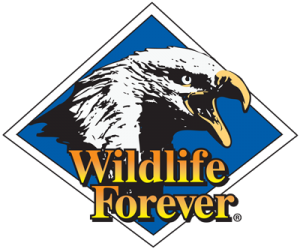Looking for some new ideas to help incorporate the State-Fish Art Contest into your teaching? Below are ideas, resources and inspiration. Do you already use the State-Fish Art Contest? Feel free to send an e-mail to JLuger@WildlifeForever.org to have your ideas incorporated here!
Fish Art Contest Materials
Fish On! Lesson Plan and Illustrated Fish Guide, Wildlife Forever
Objectives:
Students will:
- Labels the Parts of a fish and their function
- Outline a simple aquatic food chain
- explain characteristics associated with fish adaptation
- describe specific examples of fish behavior
All About FIsh
Kindergarten - 2nd grade
Fish Forms, California Academy of Sciences
Objectives:
In the Fish Forms lesson, students will:
- learn the characteristics of fish.
- create a three-dimensional sculpture.
- compare fish to other marine animals.
3rd grade - 5th grade
Aquatic Food Web, New York Department of Environmental Conservation
Objectives:
In this lesson, students will:
- Be able to identify 1-3 fish specific to fishing site.
- Be able to construct an aquatic food web.
- Be able to explain how humans play a role in the aquatic food web.
- Be able to identify species as producers, consumers, or decomposers.
Making Waves! Protecting Ontario’s Aquatic Habitats
Objectives:
In this set of lessons, students will:
- Learn about animal adaptations
- learn about aquatic food chains
- Learn about the impacts of releasing aquatic pets and plants into waterways
- discover the impacts of Zebra Mussels in the Great Lakes and Ontario’s waters
- Learn how the Great Lakes and other waterways are linked
6th grade - 8th grade
Fish Dissection, New York Department of Environmental Conservation
Objectives:
In this lesson, students will be able to:
- Identify 3-5 major external anatomical features of a fish.
- Identify the major internal organs of a fish.
- Compare and contrast human and fish internal organs, structures, and systems.
Fish Dissection, New York Department of Environmental Conservation
Objectives:
In this lesson, students will be able to:
- Identify 3-5 major external anatomical features of a fish.
- Identify the major internal organs of a fish.
- Compare and contrast human and fish internal organs, structures, and systems.
Invasive Species: A Biodiversity Challenge, Ontario’s Invading Species Awareness Program
Objectives:
In these lessons, students will gain knowledge by:
- Exploring concepts of biodiversity, systems, interactions, sustainability and stewardship;
- Determining what an invasive species is and exploring the characteristics of various invading species;
- Exploring the classification of components of a system and understand the interrelationships within the system;
- Determining major threats to biodiversity, including the role of humans in introducing invasive species;
- Participating in environmental stewardship as it relates to invasive species; and
- Exploring ways to involve their community in invasive species stewardship behaviors.
9th grade - 12th grade
Invasive Investigators, New York Department of Environmental Conservation
Objectives:
In this lesson, students will:
- Learn about several of New York states aquatic invasive species and how humans play a role in their introduction
Drawing Guides
Bluegill by Art Projects for Kids
Rainbow Trout by Art for Kids Hub
How to Fish
Online Classes by the International Game Fish Association
